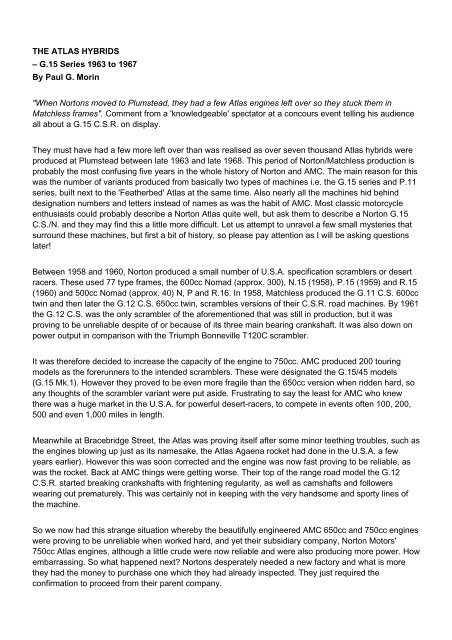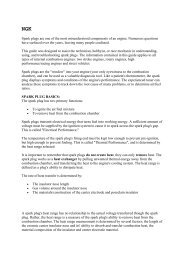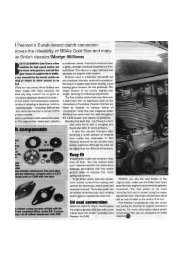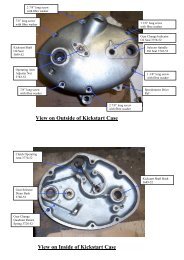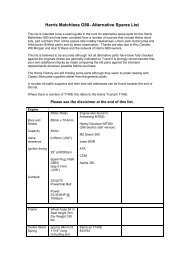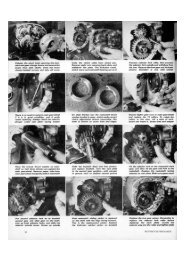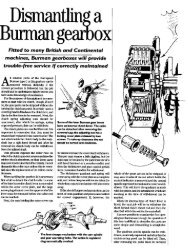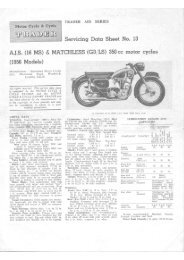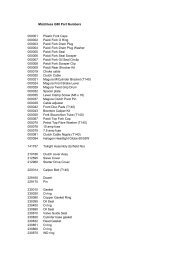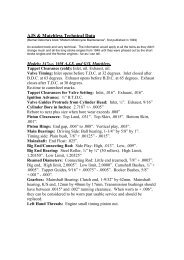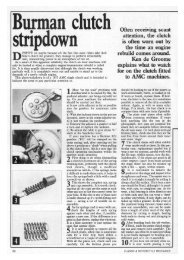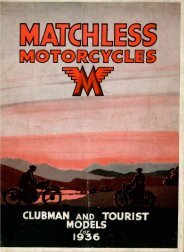THE ATLAS HYBRIDS - AJS and Matchless Archives
THE ATLAS HYBRIDS - AJS and Matchless Archives
THE ATLAS HYBRIDS - AJS and Matchless Archives
You also want an ePaper? Increase the reach of your titles
YUMPU automatically turns print PDFs into web optimized ePapers that Google loves.
<strong>THE</strong> <strong>ATLAS</strong> <strong>HYBRIDS</strong><br />
– G.15 Series 1963 to 1967<br />
By Paul G. Morin<br />
"When Nortons moved to Plumstead, they had a few Atlas engines left over so they stuck them in<br />
<strong>Matchless</strong> frames". Comment from a 'knowledgeable' spectator at a concours event telling his audience<br />
all about a G.15 C.S.R. on display.<br />
They must have had a few more left over than was realised as over seven thous<strong>and</strong> Atlas hybrids were<br />
produced at Plumstead between late 1963 <strong>and</strong> late 1968. This period of Norton/<strong>Matchless</strong> production is<br />
probably the most confusing five years in the whole history of Norton <strong>and</strong> AMC. The main reason for this<br />
was the number of variants produced from basically two types of machines i.e. the G.15 series <strong>and</strong> P.11<br />
series, built next to the 'Featherbed' Atlas at the same time. Also nearly all the machines hid behind<br />
designation numbers <strong>and</strong> letters instead of names as was the habit of AMC. Most classic motorcycle<br />
enthusiasts could probably describe a Norton Atlas quite well, but ask them to describe a Norton G.15<br />
C.S./N. <strong>and</strong> they may find this a little more difficult. Let us attempt to unravel a few small mysteries that<br />
surround these machines, but first a bit of history, so please pay attention as I will be asking questions<br />
later!<br />
Between 1958 <strong>and</strong> 1960, Norton produced a small number of U.S.A. specification scramblers or desert<br />
racers. These used 77 type frames, the 600cc Nomad (approx. 300), N.15 (1958), P.15 (1959) <strong>and</strong> R.15<br />
(1960) <strong>and</strong> 500cc Nomad (approx. 40) N, P <strong>and</strong> R.16. In 1958, <strong>Matchless</strong> produced the G.11 C.S. 600cc<br />
twin <strong>and</strong> then later the G.12 C.S. 650cc twin, scrambles versions of their C.S.R. road machines. By 1961<br />
the G.12 C.S. was the only scrambler of the aforementioned that was still in production, but it was<br />
proving to be unreliable despite of or because of its three main bearing crankshaft. It was also down on<br />
power output in comparison with the Triumph Bonneville T120C scrambler.<br />
It was therefore decided to increase the capacity of the engine to 750cc. AMC produced 200 touring<br />
models as the forerunners to the intended scramblers. These were designated the G.15/45 models<br />
(G.15 Mk.1). However they proved to be even more fragile than the 650cc version when ridden hard, so<br />
any thoughts of the scrambler variant were put aside. Frustrating to say the least for AMC who knew<br />
there was a huge market in the U.S.A. for powerful desert-racers, to compete in events often 100, 200,<br />
500 <strong>and</strong> even 1,000 miles in length.<br />
Meanwhile at Bracebridge Street, the Atlas was proving itself after some minor teething troubles, such as<br />
the engines blowing up just as its namesake, the Atlas Agaena rocket had done in the U.S.A. a few<br />
years earlier). However this was soon corrected <strong>and</strong> the engine was now fast proving to be reliable, as<br />
was the rocket. Back at AMC things were getting worse. Their top of the range road model the G.12<br />
C.S.R. started breaking crankshafts with frightening regularity, as well as camshafts <strong>and</strong> followers<br />
wearing out prematurely. This was certainly not in keeping with the very h<strong>and</strong>some <strong>and</strong> sporty lines of<br />
the machine.<br />
So we now had this strange situation whereby the beautifully engineered AMC 650cc <strong>and</strong> 750cc engines<br />
were proving to be unreliable when worked hard, <strong>and</strong> yet their subsidiary company, Norton Motors'<br />
750cc Atlas engines, although a little crude were now reliable <strong>and</strong> were also producing more power. How<br />
embarrassing. So what happened next? Nortons desperately needed a new factory <strong>and</strong> what is more<br />
they had the money to purchase one which they had already inspected. They just required the<br />
confirmation to proceed from their parent company.
AMC did not give this. Instead they ordered Norton to send them the 'factory money', closed Bracebridge<br />
Street down <strong>and</strong> moved production of all models to Plumstead. It would be a little naive to think that the<br />
two main points in this series of events, i.e. the troublesome engines at AMC <strong>and</strong> the moving of Norton<br />
production to Plumstead were unrelated. However it must be remembered that AMC were now fighting<br />
for survival. They already had a proven frame for scrambling, (the Featherbed would break below the<br />
headstock) but no reliable engine to power it, then all these Atlas engines <strong>and</strong> 'Roadholder' forks <strong>and</strong><br />
wheels mysteriously appeared at Plumstead!<br />
Engine Nos. 107388 to 124371 - Total approx. 5000<br />
In November 1963 a batch of 200 Norton 750 hybrids were leaving the Plumstead factory en-route to the<br />
American distributor, Berliner. When they arrived at their destination they would be the first delivery of<br />
the new 1964 Norton Atlas Scramblers <strong>and</strong> were the most powerful production desert-racers ever to be<br />
produced at that time. The prototype had already been thoroughly tested on the rough at Hawkstone<br />
Park by Chris Horsfield. This was the start of a four-year production run for the Atlas powered G.15<br />
series.<br />
1964 - Nos. 107388 to 110774 : Atlas Scramblers G.15C.S./N <strong>and</strong> G.15C.S./M : Approx. 1000 built<br />
All these machines used a new frame similar to the G.12 C.S. duplex type with bolt on rear subframe but<br />
were fitted with a redesigned malleable steel headstock machined to accept Norton forks <strong>and</strong> front<br />
wheel. The robust swinging-arm was of the <strong>Matchless</strong> type, but also redesigned to accept a Norton rear<br />
wheel.<br />
The arm pivoted on a hardened steel hollow spindle, the outside diameter of which ran in phosphorbronze<br />
'oilite' bushes pressed into large lugs on each side of the front of the fork. This spindle was<br />
supported by its centre portion in a sturdy single cast lug which was pinned <strong>and</strong> brazed to the vertical<br />
tube forming the rear section of the main frame, the spindle being locked in position by way of a cotter.<br />
The front forks used stanchions which were 2" longer than the Featherbed version <strong>and</strong> had special<br />
'Teledraulic' type two-way damping <strong>and</strong> external springs hidden by steel cover tubes in preference to<br />
rubber gaiters, along with st<strong>and</strong>ard Roadholder alloy sliders. The forward engine mounting lugs were<br />
positioned to accept the latest twin carburettor version of the Atlas engine. The frame/engine numbers<br />
followed the Norton system (as did all subsequent hybrids).<br />
The left side crankcase half was machined to take the AMC cast alloy primary chaincase <strong>and</strong> the<br />
gearbox shell was of the A.J.S./<strong>Matchless</strong> type with the lugs in a different position to the Featherbed<br />
shell. The scrambles petrol tank, latest type pear shaped oil tank <strong>and</strong> battery box were all <strong>Matchless</strong><br />
items <strong>and</strong> were painted in the AMC Cardinal Red of the 1961/62 G.12 series machines. (Note to<br />
restorers: apart from colour options offered by the distributor, this purple-red was the stock finish <strong>and</strong><br />
only two prototypes were in silver). The petrol tank used Norton transfers on the sides <strong>and</strong> had a single<br />
black coach-line outlined in white. A straight through exhaust system with slightly upswept ends <strong>and</strong> no<br />
silencers was employed.<br />
Contemporary photographs of a silver prototype sometimes showed the machine with the large AMC<br />
silencers. The factory used that same machine to test components for the intended touring model. The<br />
mudguards were in chrome <strong>and</strong> had a centre rib, which were similar to those used on the G.15/45 all<br />
<strong>Matchless</strong> model. This first batch also used non-folding footrests <strong>and</strong> the Lucas K2FC competition<br />
magneto. Subsequent batches had folding footrests <strong>and</strong> a st<strong>and</strong>ard K2F magneto. The reason for the<br />
change of magneto apart from cost was that it was very difficult to undo the pickup holder screws due to<br />
the close proximity of the gearbox. The machines came complete with a 12 volt lighting system.
As all subsequent G.15 series were based on the Atlas Scrambler we will now carry out an in-depth<br />
investigation into the production run <strong>and</strong> problems encountered on the first machines. It was not long<br />
before Mike Patrick the desert-racing star was notching up wins on one of these 420lb. monsters. By<br />
July 1964 a total of 600 Norton Atlas Scramblers designed G.15 C.S./N in parts ordering books <strong>and</strong> 400<br />
<strong>Matchless</strong> 750 Sports Scramblers designed (<strong>and</strong> engine stamped) G.15 C.S./M had been produced. The<br />
<strong>Matchless</strong> version was finished in chromatic C<strong>and</strong>y Apple Red <strong>and</strong> the petrol tank was silver coach-lined<br />
with pinstripe <strong>and</strong> used the 1959-1962 round plastic badges, the engine numbers commencing at<br />
108638 with the last batches starting to use rubber gaiters on the forks.<br />
All these first machines went to Berliner, the main distributor in the USA. There must have been quite a<br />
hectic rush at the factory to get the scramblers built because there were a few 'oversights' on the first<br />
batches. One was that it was impossible to remove the cylinder head in situ because even when the<br />
exhaust rocker spindles were extracted there still was not enough clearance between the top frame tube,<br />
to tilt the head back <strong>and</strong> withdraw the push rods because the three cylinder head studs were about 1/8"<br />
too long, necessitating lowering of the engine. These studs were shortened on all subsequent Atlas<br />
engines. Another problem was in the adjusting of the magneto chain or taking off the magneto. Once<br />
again because of the close proximity of the gearbox to the engine, the nut on the bottom magneto fixing<br />
stud was inaccessible. This of course was not a problem on the Featherbed because of the gearbox<br />
being half a mile away from the engine. The factory corrected this with a modification to the right-side<br />
crankcase half using a nut <strong>and</strong> bolt arrangement for the bottom magneto fixing point so that this could<br />
now be loosened from inside the timing cover. All subsequent Atlas engines received this. Rushed<br />
production also meant that even though the new wider forks were used, the steering anti-theft locks were<br />
not available, neither was the new magnetic tachometer. Therefore the first batch went out without the<br />
locks <strong>and</strong> with magnetic speedometers <strong>and</strong> chronometric tachometers.<br />
Improvements to the next batches were a tighter turning circle achieved by machining more material<br />
from the crown 'lock stops' <strong>and</strong> also longer centre st<strong>and</strong> feet because it was soon discovered that with<br />
scrambles tyres fitted, when the machine was on the st<strong>and</strong> with the engine ticking over, the bike would<br />
creep along on its own <strong>and</strong> disappear down the end of the road. A most amazing omission was that the<br />
inner primary chaincase was only secured at the front. This was by way of the three cheese-headed<br />
screws, but the rear was unsupported. This was later corrected by including another stud which secured<br />
the centre area to the left engine plate. Even so, these hiccups on the first batch, which were quickly<br />
rectified, didn't appear to have dampened enthusiasm for the 'export only' Atlas Scramblers <strong>and</strong> going by<br />
contemporary tests of the machines, they were very well received, probably because most of these<br />
errors were in servicing or 'surplus equipment' rather than actual performance in the desert.<br />
1965 - 1967 - Nos. 111926 to 124371 : N.15 C.S <strong>and</strong> G.15 C.S. : Approx. 2,500 built<br />
1965 to 1966<br />
These later machines were closely based on the Atlas Scramblers but now had modified front fork<br />
action, rubber gaiters, <strong>and</strong> stronger head-steady. The oil tank was 'set in' an extra 1/2" at the front to suit<br />
the slimmer sports seat which was also used on the earlier G.12 C.S./C.S.R. models. The Norton was<br />
now named the N.15 C.S. <strong>and</strong> the engine number was preceded by this designation. The <strong>Matchless</strong> was<br />
named <strong>and</strong> engine stamped G.15 C.S. which was the identical stamping for early Norton Atlas<br />
Scramblers, ensuring mayhem for later restorers. Both machines were now identical in C<strong>and</strong>y Apple<br />
Red, only the plastic tank badges being different although the <strong>Matchless</strong> now used the new 'winged'<br />
items. Some of the smaller batches were finished in non-chromatic blue or chromatic green.
1966 to 1967<br />
Another cosmetic re-vamp included less bulky mudguards without the centre rib, the new side-bulge<br />
badge area petrol tank <strong>and</strong> a more modern looking seat without piping but with a plastic-chrome bottom<br />
edging. The forks now had internal springs but by this time the machine was a 'Street Scrambler' <strong>and</strong><br />
had long lost its 'Atlas Scrambler' tag, with both versions now using Norton silencers. So the true Norton<br />
Atlas Scramblers were only the six hundred up to July 1964 <strong>and</strong> finished in Cardinal Red. The first batch<br />
of two hundred which had engine numbers stamped G.15 C.S. 107388 to 107588 would presumably be<br />
the most collectable being more individualistic. All 750 hybrids had the frame numbers stamped vertically<br />
in line down the left side of the headstock but early Atlas Scramblers had each individual number<br />
stamped sideways but still in a vertical line.<br />
1964 - 1967 Nos. 109038 to 123570 : G.15 Mk.11, G.15P, <strong>and</strong> 33 : Approx. 1000 built<br />
G.15 Mk.11<br />
At the same time when the original Atlas Scramblers were being produced, a touring version based on<br />
these machines was planned for mid-1964. These had a four gallon <strong>Matchless</strong> tank usually in black with<br />
a coach-line <strong>and</strong> pinstripe in a zigzag flash, <strong>and</strong> large 'knee-knocker' cast badges (which were replaced<br />
in 1965 with the 'winged' plastic items), large deeply-valanced chrome mudguards, conventional exhaust<br />
system with the large AMC silencers <strong>and</strong> were traditionally European styled. The machine used the<br />
same frame as the scrambler models but the front forks although still extended two inches had<br />
Roadholder damping <strong>and</strong> internal springs. It was an excellent sidecar machine. The designation was<br />
G.15 Mk.11 to differentiate it from the discontinued all <strong>Matchless</strong> G.15/45 tourer. Confusion was still to<br />
occur in the future for restorers however, because early batches were crankcase stamped G.15 C.S.<br />
XXXXXX M2. The C.S. stamping was dropped in 1965 <strong>and</strong> later that year the M2 stamping was also<br />
discontinued. The Mk.11 continued production until 1967 with some export machines having a chromesided<br />
petrol tank finished in C<strong>and</strong>y Apple Red.<br />
G.15P<br />
This was a single seat version of the Mk.11 produced in small numbers during 1964, presumably for<br />
'forces' work. The mudguards used would differ if the machine was to be an 'export' or 'home' model <strong>and</strong><br />
whether it was to be designated a Norton or <strong>Matchless</strong> i.e. G.15P/N or G.15P/M. The guards therefore<br />
could be either painted or chrome, <strong>and</strong> could be the G.15 Mk.11 type or the lighter ES2 Mk.11 type.<br />
(Note to restorers: in 1964, parts for the G15 Mk.11 were listed under G.15P).<br />
33<br />
From 1965 to 1967 an A.J.S. version was produced, named the 'Model 33'. It was finished in either black<br />
or chromatic blue. The petrol tank had a gold zigzag flash <strong>and</strong> the motifs were the large cast items<br />
changing to the smaller plastic 'diamond' shaped badges for 1966. Only about 50 machines were<br />
produced. The engine number was stamped 33.<br />
1965 - 1967 Nos. 112476 to 123465 : G.15 C.S.R. <strong>and</strong> 33 C.S.R. Approx. 500 'café-racer' types +<br />
100 others<br />
In November 1964 at the Earls Court show there appeared another variant. This prototype machine was<br />
the forerunner for the flagships of all Atlas powered hybrids. It was a sports model in 'café-racer' trim with<br />
the designation G.15 C.S.R. An A.J.S. version in chromatic blue was to be the 33 C.S.R. <strong>and</strong> in the USA<br />
the distributor Berliner would sometimes change the <strong>Matchless</strong> badges to Norton, calling the machine<br />
the Norton S/S 750.
The 1965 production models had swept back exhaust pipes (the only stock motorcycle from any<br />
manufacturer to offer these as st<strong>and</strong>ard equipment) with the large <strong>Matchless</strong> silencers. Only the show<br />
prototype 'café-racer' had Norton silencers. A large 4 gallon chrome-sided petrol tank in C<strong>and</strong>y Apple<br />
Red was fitted which was possibly the most pleasing tank ever produced in the mid-sixties (from 1966<br />
the G.15 Mk.11 also used this tank on export machines). The A.J.S. 33 C.S.R. was finished in chromatic<br />
blue but only about 50 of these were produced. The racing image continued with 12.9" rear suspension<br />
units (the C.S. used 13.4") with top covers chromed <strong>and</strong> bottom covers removed exposing the plated<br />
reverse-coil springs, rearset footrests, short rear-brake pedal, rear-facing gear change lever with reverse<br />
camplate inside the gear-box thus allowing normal selection, polished dural mudguards <strong>and</strong> the AMC<br />
sports seat all ensuring the machine looked capable of exceeding 'the ton'.<br />
Fast it was, with one electronically timed highest one-way speed of 115 mph (on 7.6:1 pistons) in a<br />
contemporary road test of what now appears to be one of the most collectable sports machines to own.<br />
The C.S.R continued production through 1966 (when the 18" wheels were changed to 19", thus slightly<br />
increasing the gearing as both sizes used 3.50 rear tyres) until early 1967. The last 'café-racer' was<br />
120511. After this the 33 C.S.R. was dropped <strong>and</strong> the <strong>Matchless</strong> lost its 'café-racer' status, (a sure<br />
indication that the Rocker period had passed) <strong>and</strong> coil/Concentric models with st<strong>and</strong>ard footrests <strong>and</strong><br />
normal exhaust-pipes using Norton silencers converted the machine into a 'sports tourer' (approx. 50<br />
produced). The 'café-racer' C.S.R. machines did not use Norton silencers because of clearance<br />
problems with the positioning of the rearset items.<br />
However an unusual final batch in mid-1967 was produced. The large petrol tank was replaced with a 2<br />
gallon scrambles item but with chrome sides, <strong>and</strong> with high 'ape-hanger' h<strong>and</strong>lebars the C.S.R.<br />
capitulated as an American styled 'street machine' (approx. 50 produced).<br />
During this period the <strong>Matchless</strong> engined 650cc G.12 C.S.R. had finally been made more reliable by the<br />
fitting of a 'nodular' crankshaft, stellite tipped cam followers <strong>and</strong> increased oil pressure, but it all came<br />
too late <strong>and</strong> they had lost the good name <strong>and</strong> status to the G.15 C.S.R. but rather interestingly from<br />
1964 they also used Norton forks <strong>and</strong> wheels <strong>and</strong> were styled more as a tourer. (Note to restorers: the<br />
frames used on these machines whilst looking identical to the G.15 frames of the same years, are<br />
however different in that the engine mounting lugs are positioned for the <strong>Matchless</strong> engines).<br />
So it now becomes more obvious why these hybrids were produced. The only true comparison between<br />
the Featherbed models <strong>and</strong> the G.15 hybrids would be to put a Norton Atlas next to a <strong>Matchless</strong> G.15<br />
C.S.R. as it would be a sensible question to ask why these two machines were produced at the same<br />
time. The answer may be 'badge allegiance' but I will try to compare the differences in actually using<br />
them from 'memorable' experiences gained at the time they were produced. The machines were a 1961<br />
G.12 C.S.R., then a 1964 Norton Atlas ordered untuned (but with rear-set footrests, ace bars <strong>and</strong> 19"<br />
rear wheel with G.P. tyre) from Paul Dunstall <strong>and</strong> finally a 1967 G.15 C.S.R. café-racer.<br />
Bearing in mind the scrambler parenthood of the G.15 C.S.R. frame, it is quite amazing that it had any<br />
high-speed road-holding qualities at all. In fact, properly set up it was very good, better than the G.12<br />
C.S.R. <strong>and</strong> almost on a par with the Featherbed at speed <strong>and</strong> on fast bends. "Aha" I hear you shout,<br />
"that's because it had Roadholder forks". However, lower down the speed scale the Featherbed was<br />
more 'flickable' for roundabout 'sweeping' <strong>and</strong> more sure-footed in the wet. Both frame types are<br />
stretched to the limit with the power of the Atlas engine as Paul Dunstall had discovered <strong>and</strong> he<br />
subsequently used 'Low-Boy' <strong>and</strong> then special frames for his Atlas engined 'Domiracer 750' machines.
On really quick bends the Featherbed had a controlled 'drift' whilst the G.15 C.S.R. had a tendency for a<br />
slight rear-end weave. Vibration was similar but slightly less on the G.15 C.S.R. for some unknown<br />
reason but neither were excessive in this. The vibration (only at high revs) on the <strong>Matchless</strong> engined<br />
G.12 C.S.R. however was high-pitched, sonic <strong>and</strong> destructive, yet for normal use this machine was the<br />
least fussy of the three, albeit with less power available.<br />
Servicing was easier on the Featherbed but the alloy chaincase on the C.S.R. was a better arrangement,<br />
however bearing in mind the machines were new, there were no oil leaks from the Norton chaincase<br />
either. The <strong>Matchless</strong> was more comfortable on long journeys or when carrying a pillion passenger but<br />
the Norton was more easy to manoeuvre in traffic conditions. The Atlas centre-st<strong>and</strong> foot-peg had to be<br />
cut off for safety on fast corners but even so the Featherbed would still ground before the C.S.R.<br />
Exhaust notes were all very 'healthy,' but I must confess a preference for the deep 'burble' of the<br />
<strong>Matchless</strong> 650 engine.<br />
Styling is more of a personal requiremen; perhaps the smooth lines of the Norton Atlas or the aggressive<br />
lines of the C.S.R. reflect the hidden personality of the owner. Should anyone own both an Atlas <strong>and</strong> a<br />
G.15 C.S.R., Hycam can now offer psychiatric help! Note: take care not to interchange the rear wheel<br />
spindle spacers of these two machines - they are of different lengths. Therefore it would appear that<br />
personal taste played (<strong>and</strong> still plays) a large part in the comparison of two of the fastest machines of<br />
that time.<br />
AMC employed 'series production' during this period which meant that improvements, modifications <strong>and</strong><br />
new styling would be introduced into the next batch of machines, instead of waiting for the traditional<br />
'show' time, therefore there will be many instances of overlap with intermediate models to the stated<br />
changes in this article. However the introduction of the six-start oil pump gears, <strong>and</strong> the change from<br />
magneto <strong>and</strong> Monoblocs to coils <strong>and</strong> Concentrics occurred at the same time on the G.15 series as on<br />
the Featherbed Atlas.<br />
The chromatic paint finishes referred to (e.g. C<strong>and</strong>y Apple Red) were achieved by applying the top<br />
colour over a silver base giving a transluscent effect <strong>and</strong> thus the more coats applied - the deeper the<br />
shade. This sometimes caused shadowing if the colour was not applied evenly <strong>and</strong> also caused<br />
variations in the shade from batch to batch.<br />
Perhaps it would be in order here to compare the differences in performance with a st<strong>and</strong>ard Atlas<br />
engine fitted with magneto <strong>and</strong> Monoblocs <strong>and</strong> then coil <strong>and</strong> Concentrics. There is no question to my<br />
mind that the magneto/Monobloc set-up provides far more flat-out power reflected in overall quicker<br />
performance but with a price to pay. Coil/Concentrics make for easier 'hot' starting, smoother<br />
performance, a more even tickover <strong>and</strong> far better fuel consumption. However, my own preference is for<br />
magneto <strong>and</strong> opposite Monoblocs 389/689 because assuming the carburettor bodies are not distorted,<br />
(sometimes they distort only when hot causing all manner of problems), then you have a compromise<br />
with good performance <strong>and</strong> reasonable fuel consumption.<br />
The early twin-carb. Atlas engine with two 389 bodies, the right-h<strong>and</strong> one having the fuel chamber<br />
chopped off, were exceptionally heavy on fuel. The 1964 Atlas described had this arrangement <strong>and</strong> with<br />
the air-filter removed, the main jets recommended were 440 returning a consumption figure under hard<br />
riding of 35 mpg! But did it go! On several occasions under favourable conditions it pulled 6800 rpm in<br />
top (without clutch-slip) giving 117 mph. The main jets for opposite Monoblocs 389/689 should be about<br />
360, returning about 50 mpg on average riding, <strong>and</strong> for Concentrics the jets should be about 260,<br />
returning about 60 mpg.
And so by mid-1967 the G.15 series had come to an end. Many unsold machines were put into stock<br />
<strong>and</strong> later sold as 1968 models. A few were even registered in Britain as late as 1970, a good indication<br />
that the series had overrun its time. But back to 1967, the hybrid builders at AMC, or by this time Norton-<br />
Villiers had not quite finished yet. With a flourish of activity they planned <strong>and</strong> produced another series of<br />
hybrids that were completely different from previous machines but still used the Atlas engine for power<br />
<strong>and</strong> although production was short-lived, they were even more spectacular <strong>and</strong> caused just as much<br />
confusion to restorers many years later - the notorious P.11 series.<br />
Highest speeds on st<strong>and</strong>ard gearing under favourable conditions, but not<br />
sustainable<br />
Engine Sprocket Gearbox Sprocket Model Speed Rear Tyre<br />
21 19 Norton Atlas 110 mph @ 6400<br />
rpm (M)<br />
21 17 N.15 C.S. <strong>and</strong> G.15<br />
C.S.<br />
100 mph @ 6400<br />
rpm (M)<br />
22 17 G.15 Mk.11 104 mph @ 6400<br />
rpm (M)<br />
22 19 G.15 C.S.R. 115 mph @ 6600<br />
rpm (M)<br />
116 mph @ 6400<br />
rpm (M)<br />
22 19 G.15 C.S.R. (U.S.A.) 106 mph @ 6000<br />
rpm (C)<br />
21 19 P.11 105 mph @ 6200<br />
rpm (C)<br />
M = magneto/Monoblocs . C = coils/Concentrics<br />
18 x 4.00<br />
19 x 3.50<br />
18 x 4.00<br />
18 x 4.00<br />
18 x 3.50<br />
19 x 3.50<br />
19 x 3.50<br />
18 x 4.00<br />
These figures are based on electronically timed speed tests. It should be remembered that these were<br />
stock twin carb. machines with gearing <strong>and</strong> riding positions as delivered. It is often not fully appreciated<br />
that gearing/riding position can alter the top speeds using the same engine by over ten miles per hour-<br />
As a general rule a machine later fitted with small-bore exhaust-pipes, low bars <strong>and</strong> rear-set footrests will<br />
increase the top speed quoted by approx. 3 mph (apart from the G.15 C.S.R. 'café racer' which had this<br />
set-up as st<strong>and</strong>ard equipment). A dolphin type fairing would give another 3 mph or a full dustbin 6 mph.<br />
Realistic short period top-speeds would be approx. 10 mph less than the quoted figures <strong>and</strong> long period<br />
top-speeds approx. 20 mph less with comfortable cruising at approx 35 mph less. The maximum power<br />
is at 6400 rpm with a safe maximum at 6800 rpm although this is not attainable in top gear on st<strong>and</strong>ard<br />
machines.<br />
Cruising speeds should be just above or below the 4500 rpm vibration peak. Atlas crankshafts should<br />
never be dynamically rebalanced if they are to be used on the road. They already have an 80% balance<br />
factor <strong>and</strong> any further balancing will only shift the vibration period to a different range. If this period<br />
comes in at your chosen cruising speed, just alter the gearing. It is not recommended that P.11 series<br />
machines be converted to café-racing specification <strong>and</strong> used as such. You will fall off <strong>and</strong> anyway there<br />
aren't enough cafés left to race to. Should much higher top-speeds than those quoted be claimed, then<br />
the machine either had clutch-slip whilst the tachometer was being read or a tuned-up speedometer was
fitted. The fitting of 9:1 pistons alone will make the engine less tractable at low speeds, may increase<br />
mid-range acceleration but will not increase the absolute top-speed. However it may lengthen the time<br />
that the non-sustainable top-speed can be held. Tappet clearances should be increased by .002"<br />
(.05mm). It is also recommended that a 'Superblend' type main bearing be fitted to the drive-side. Should<br />
a Superblend also be fitted to the timing side in place of the original type ball race, check crankshaft end<br />
float as per manual. Should a complete Comm<strong>and</strong>o engine be put into a Featherbed or hybrid frame, the<br />
crankshaft must be changed to the Atlas balance factor.<br />
Ignition timings (fully advanced)<br />
7.6 : 1 Concave crown 32 degrees<br />
B.T.D.C.<br />
9.0 : 1 Flat crown 28 degrees<br />
B.T.D.C.


